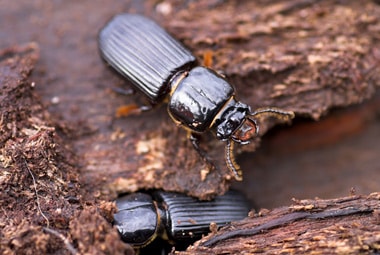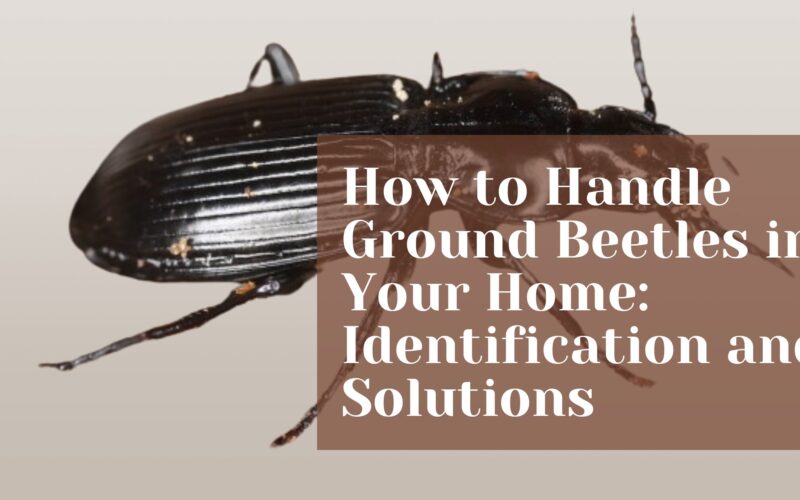Ground beetles are a common household nuisance that many homeowners encounter. While they are generally harmless to humans and pets, their presence can be unsettling.They are often found in dark, damp areas such as basements, kitchens, and bathrooms.
To prevent ground beetles from entering your home, make sure to seal any cracks or openings they could use as entry points. Additionally, reducing moisture levels in your house can help deter these pests. If their presence becomes overwhelming, consider contacting a pest control professional for assistance in managing the infestation.
This comprehensive guide will help you identify ground beetles, understand why they enter homes, and learn how to handle ground beetles in your home. It will also provide effective strategies for managing and preventing infestations.
Understanding Ground Beetles In Your Home
Ground beetles belong to the family Carabidae, comprising over 40,000 species worldwide. They are typically black or dark brown, with elongated bodies and long legs. Ground beetles are beneficial insects in gardens, as they feed on pests like aphids, slugs, and caterpillars.
However, when they find their way into homes, they can become an unwelcome presence.
Identification Of Ground Beetles
Identifying ground beetles is the first step in managing them. Here are some key characteristics:
- Size: Ground beetles vary in size, ranging from 1/8 inch to over 1 inch in length.
- Color: Most are black or dark brown, but some species may have metallic hues.
- Shape: They have elongated bodies with prominent mandibles.
- Legs: Long legs allow them to move quickly.
- Antennae: They have long, slender antennae.
Ground beetles are nocturnal and often attracted to lights. They prefer to stay hidden during the day, making them difficult to spot until they become more active at night.
Why Ground Beetles Enter Homes

Understanding why ground beetles enter homes can help prevent their intrusion. Several factors can attract these insects indoors:
Ground Beetles Seeking Shelter
Ground beetles often seek shelter in homes, especially during adverse weather conditions. Heavy rain, extreme heat, or cold can drive them inside in search of a more stable environment.
To prevent ground beetles from entering your home, make sure to seal any cracks or openings in doors, windows, and walls. Additionally, keeping outdoor lights off at night can help reduce their attraction to your home.
If you do find ground beetles inside, gently capture and release them back outdoors to ensure both your home and the beetles remain undisturbed.
Food Sources For Ground Beetles
Although ground beetles primarily feed on other insects, they may enter homes in search of food. They are attracted to areas where other pests are present, such as kitchens, basements, and garages.
If ground beetles find their way inside, it is best to address any other pest issues promptly to deter their presence. Regular cleaning and maintenance habits can help reduce potential attractants for these beneficial yet intrusive insects.
Attraction of Light For Ground Beetles
Like many nocturnal insects, ground beetles are drawn to artificial light sources. Outdoor lighting or windows can attract them, leading them to enter homes through gaps and cracks.
When ground beetles make their way indoors, they often seek shelter in dark, secluded areas such as basements, attics, and storage spaces. These insects are usually harmless to humans but can startle and annoy with their sudden appearances.
To prevent them from entering your home, it is advisable to seal any openings where they could gain access and consider using yellow or sodium vapor lights outside, as these are less attractive to nocturnal insects.
Moisture
Ground beetles thrive in moist environments. Leaky pipes, damp basements, and high humidity levels can attract them indoors.
Managing Ground Beetle Infestations
If you find ground beetles in your home, there are several steps you can take to manage and eliminate the infestation:
Inspection
Start by conducting a thorough inspection of your home to identify entry points and infested areas. Common entry points include:
- Gaps around doors and windows
- Cracks in the foundation
- Vents and utility openings
- Gaps around pipes and cables
Exclusion of Ground Beetles
Preventing ground beetles from entering your home is crucial. Here are some exclusion techniques:
- Seal Cracks and Gaps: Use caulk or weatherstripping to seal any gaps around doors, windows, and utility openings.
- Install Door Sweeps: Install door sweeps on exterior doors to close gaps between the door and the threshold.
- Repair Screens: Fix or replace damaged window and door screens.
- Use Mesh Covers: Cover vents and utility openings with fine mesh to prevent beetles from entering.
Indoor Control
If ground beetles have already entered your home, indoor control measures are necessary:
- Vacuuming: Use a vacuum cleaner to remove ground beetles from floors, walls, and other surfaces. Be sure to dispose of the vacuum bag or contents immediately.
- Sticky Traps: Place sticky traps in areas where ground beetles are commonly seen. These traps can help monitor and reduce the population.
- Chemical Control: Insecticides can be used as a last resort. Look for products labeled for ground beetle control and follow the manufacturer’s instructions carefully.
Outdoor Control
Controlling ground beetles outside your home can help prevent them from entering:
- Reduce Outdoor Lighting: Use yellow or sodium vapor lights, which are less attractive to insects.
- Eliminate Hiding Places: Remove debris, leaf litter, and mulch from around the foundation of your home.
- Maintain Landscaping: Keep grass and vegetation trimmed and away from the foundation.
- Control Moisture: Fix leaky faucets, downspouts, and gutters to reduce moisture around your home.
Long-Term Prevention
Implementing long-term prevention strategies can help keep ground beetles out of your home:
Regular Inspections
Perform regular inspections of your home to identify and address potential entry points. Check for cracks, gaps, and other vulnerabilities that could allow ground beetles to enter.
Home Maintenance
Maintain your home by addressing any issues that could attract ground beetles. This includes:
- Sealing Gaps and Cracks: Regularly inspect and seal gaps and cracks around doors, windows, and the foundation.
- Repairing Screens: Ensure that window and door screens are in good condition.
- Managing Moisture: Fix leaks and reduce humidity levels in your home.
Pest Control
Implement a pest control program to manage other pests that may attract ground beetles. This can include regular inspections and treatments by a professional pest control service.
Landscaping
Maintain your landscaping to reduce the likelihood of ground beetles finding their way into your home:
- Trim Vegetation: Keep vegetation trimmed and away from the foundation.
- Remove Debris: Regularly remove leaf litter, mulch, and other debris from around your home.
- Control Moisture: Address any drainage issues and fix leaky faucets and downspouts.
Natural and DIY Solutions
For those who prefer natural or DIY solutions, there are several options for managing ground beetles:
Diatomaceous Earth
Diatomaceous earth is a natural powder made from fossilized algae. It can be sprinkled around entry points and areas where ground beetles are found.The powder dehydrates and kills insects upon contact.Ground beetles are primarily nocturnal creatures that feast on various garden pests.
By using diatomaceous earth as a natural and non-toxic method of pest control, you can effectively manage the population of ground beetles in your garden without harming other beneficial insects. Remember to reapply the powder after rain or heavy watering to ensure its effectiveness in deterring these pests.
Essential Oils
Certain essential oils, such as peppermint, lavender, and eucalyptus, can repel ground beetles.
Mix a few drops of essential oil with water and spray it around entry points and infested areas.
Homemade Traps
One effective method for capturing ground beetles is to make your own homemade traps. To do this, you should set up a shallow dish that is filled with soapy water and place it strategically near a light source.
The light will draw the beetles in, as they are often attracted to bright illumination. Once they get close enough, the beetles will inevitably fall into the water, where they will unfortunately be unable to escape and will ultimately drown. This simple yet effective trap can help manage the population of ground beetles in your area.
Professional Pest Control
If your ground beetle problem persists despite your efforts, it may be time to call in a professional pest control service. Professionals can provide:
- Expert Inspection: A thorough inspection to identify entry points and infested areas.
- Targeted Treatments: Effective treatments tailored to your specific situation.
- Ongoing Monitoring: Regular monitoring and maintenance to prevent future infestations.
Conclusion
Ground beetles can be a nuisance when they invade homes, but with proper identification, prevention, and control measures, you can manage and eliminate these pests.Regular inspections, home maintenance, and natural solutions can help keep ground beetles at bay.
If needed, professional pest control services can provide effective and long-lasting solutions.By taking proactive steps, you can ensure that your home remains free from ground beetles and other unwanted pests.
Remember that a clean and well-sealed home is a key factor in preventing ground beetles infestations.By addressing any entry points, reducing excess moisture, and maintaining proper sanitation, you can effectively deter these pests from invading your living spaces.
Additionally, spreading diatomaceous earth or using sticky traps can be practical ways to control ground beetles if they do find their way indoors.Always remember that a proactive approach is the best defense against unwanted intruders in your home.
